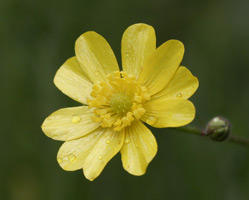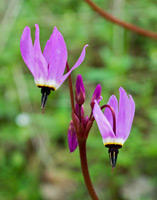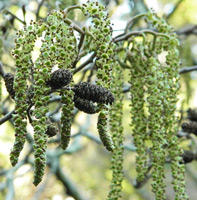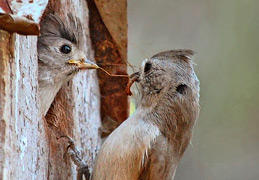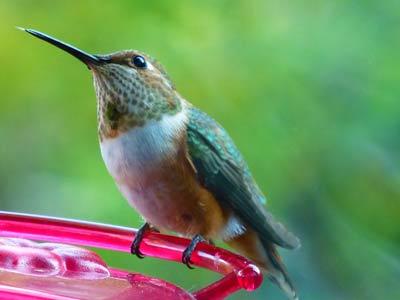February Nature News
January is the prologue to California spring: greening hills, a few flowering plants, and the precocious outliers of the bird world like owls and hummingbirds beginning their nesting activity. But February is when things really start cooking.
|
Buttercup |
Shooting Star |
Hound's Tongue |
A whole bunch of different trees flower or leaf out in February, from the big valley oaks on the round green hills, to buckeyes unclenching their leaf bud fists into those fresh and quirky five-fingered leaves, to the alders along the creeks festooned with green-golden catkins. Meanwhile, a variety of early season wildflowers will bloom this month: now is the time to pick up a local flower guide. Some flowering can be triggered in December or January by rain or warm weather, but it is February’s surest of signs - lengthening days, with more available sunlight - that steps both plants and animals irrevocably into the changes of spring. Insects emerge to feed on fresh plant growth and nectar-bearing flowers, and both that plant material and the insects themselves contribute to the food available for birds. This growing bounty of increasingly abundant food will be one of the main prerequisites to successful nesting, a stressful endeavor at the best of times as a pair of small songbirds attempts to feed not only themselves, but also their 4–7 offspring over the course of the several week voyage from egg to independence.
How does the nesting season begin? With song.
Perhaps your ears have become too inured to our myriad mechanical and recorded noises and the yearly explosion of birdsong has never yet really registered on your awareness. In that case, you have something wonderful to look forward to this month! Just step outside your house early in the morning, or better yet step out into a nice diverse woodland area with lots of different trees and plants.
|
Alder Flowers |
Some keep the Sabbath going to Church –
I keep it, staying at Home –
With a Bobolink for a Chorister –
And an Orchard, for a Dome –
Some keep the Sabbath in Surplice –
I, just wear my Wings –
And instead of tolling the Bell, for Church,
Our little Sexton – sings.
God preaches, a noted Clergyman –
And the sermon is never long,
So instead of getting to Heaven, at last –
I’m going, all along.
– Emily Dickinson
We don’t have bobolinks here (a grassland blackbird family bird - kind of like meadowlarks), but the sentiment is equally applicable: birdsong can strike our first and perfectly valid level of perception simply as a radiant outpouring of life and vitality that seems to embody heavenly divinity much more directly than the tedious intermediaries of long-winded clergymen or verbose bird store newsletter-writers. So feel free to turn off the computer, step out under the trees, and listen if the present sermon starts to drag.
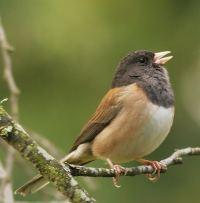 Of course, birds are not merely singing for our pleasure. The basic evolutionary reason for birdsong is as a means of demonstrating one’s health and fitness to potential mates and for declaring one’s preparedness to defend a territory. The diversity of our reactions to the musical content of different birds’ songs should be a warning against applying our exact sentiments to the singers: in the abstract, many people think of birdsong as joyful, but the minor-key melodies of say golden-crowned sparrows and hermit thrushes are apt to strike the average human as more melancholy in tone. In short, the birds are not simply “singing with joy” (or with plaintive depression). But neither are they actually thinking of the biological “purpose” they are executing. Instead, they have a strong instinctive and on some level emotional drive to sing without knowing exactly why - a feeling which we cannot fully understand, but which we can plausibly connect with feelings of health, vigor, and in some birds a more or less monogamous attraction to their mate.
Of course, birds are not merely singing for our pleasure. The basic evolutionary reason for birdsong is as a means of demonstrating one’s health and fitness to potential mates and for declaring one’s preparedness to defend a territory. The diversity of our reactions to the musical content of different birds’ songs should be a warning against applying our exact sentiments to the singers: in the abstract, many people think of birdsong as joyful, but the minor-key melodies of say golden-crowned sparrows and hermit thrushes are apt to strike the average human as more melancholy in tone. In short, the birds are not simply “singing with joy” (or with plaintive depression). But neither are they actually thinking of the biological “purpose” they are executing. Instead, they have a strong instinctive and on some level emotional drive to sing without knowing exactly why - a feeling which we cannot fully understand, but which we can plausibly connect with feelings of health, vigor, and in some birds a more or less monogamous attraction to their mate.
A great many of our backyard birds are now singing: house finches, goldfinches, titmice, juncos, Bewick’s wrens, and more. If you want to start learning birdsong, the best way is to go outside with your binoculars and find the bird. Try to describe the song in a way that makes sense to you, whether with a mnemonic like “oh-dear-me” or with a description like “three clear high whistles descending in pitch” for the song of the golden-crowned sparrow, for instance.
A good field guide will have descriptions of birdsongs as well. Once you’ve recognized a singer in your yard, read your field guide’s description and try to relate it to what you’ve heard to help put it in verbal terms our brains can remember. Another useful tool is Cornell’s All About Birds website, which has recordings for all the birds you will encounter singing in your yard (although some birds have more variable songs than others). You can started with an overview of a few of our common backyard bird songs in our own Spring Birdsong article.
For most birds, the next steps - actual nest construction and egg-laying - will wait until the upcoming months. But there are a few backyard songbirds who can actually begin nesting in February. Many of this early-nesting group share a few characteristics: they nest in tree cavities or birdhouses (where the nests will be more protected from late winter storms than open nests) and they are year-round residents rather than migratory birds (who are only just starting to arrive here). The main potential yard birds in this category are oak titmice, chestnut-backed chickadees, Bewick’s wrens, and western bluebirds. All of these birds can be attracted to an appropriately sized and placed nesting box - see our Attracting Nesting Birds for more.
|
Oak Titmice - Early House-Nester |
Allen's Hummingbird - Early Migrant |
Meanwhile, the first few migrant birds are now arriving. The earliest, who began appearing last month, are Allen’s hummingbirds. These guys are smaller than our year-round Anna’s hummingbirds and can be identified by their rusty-orange flanks. You may also see them performing their own distinctive courtship dive. While Anna’s simply climb to a great height and then come plummeting down with a loud chirp at the bottom, Allen’s hummingbirds precede each climb-and-dive with some back and forth shuttling flights, generally accompanied by some audible wing noise as they make their turns.
Two other birds that you may notice, particularly around bodies of water, are tree swallows and violet-green swallows. A few of these speedy insect-eaters overwinter with us, but many more arrive for the summer, with their numbers starting to pick up this month. These two swallow species are unique among our several local swallows in that they nest in individual pairs in tree cavities or nest boxes (the same size as those used for bluebirds - and they often occupy similar habitats as bluebirds as well - open areas with some large, mature trees, usually oaks around here). If you want some natural insect control in your yard, you couldn’t do much better than to host a nesting pair of the elfin violet-green swallow.
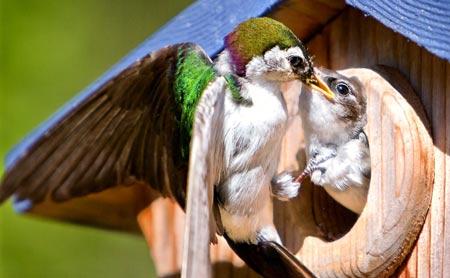 Violet-green swallow with chick - local photo by Christine Hansen
Violet-green swallow with chick - local photo by Christine Hansen
As for departures, there aren’t many yet! February is a fun month where you get to enjoy both the great diversity of winter birds along with the incipient nesting behavior of our year-round residents. In the backyard, the abundant winter sparrows will remain generally common through March, after which they will gradually thin out. Our winter warblers, Townsend’s and yellow-rumped warblers, will continue to visit feeders for suet or mealworms, though they may begin to be more distracted as insect abundance increases. Beyond the yard though, February marks the last month of really strong waterfowl abundance, as many duck species begin to move north this month, a process which will continue in March. The peak time to visit local bodies of water and see the maximum abundance and diversity of ducks is now drawing to a close: head out soon to Las Gallinas in San Rafael, Shollenberger & Ellis Creek in Petaluma, and Hamilton, Rush Creek, and the Bahia Lagoon in Novato.
|
Did you miss our January Nature News? |
See what's next in our March Nature News |


